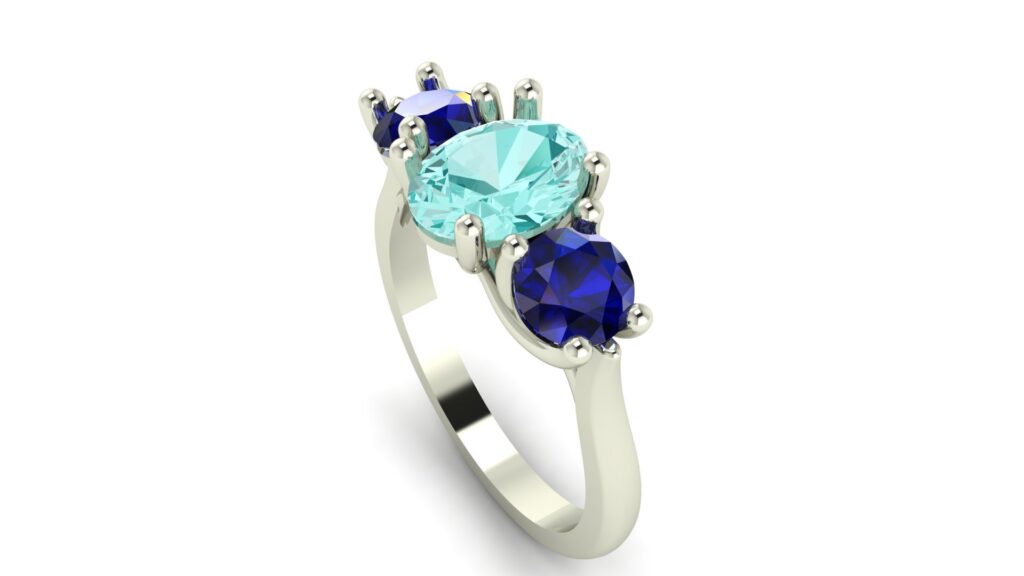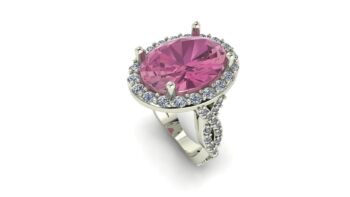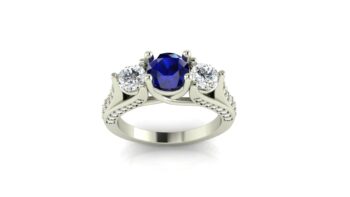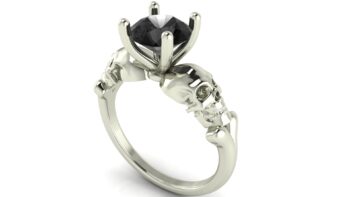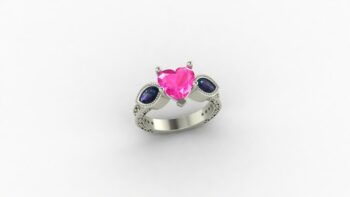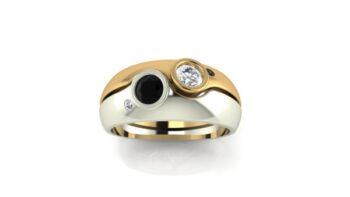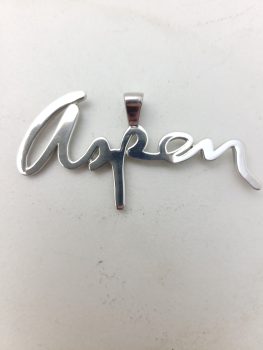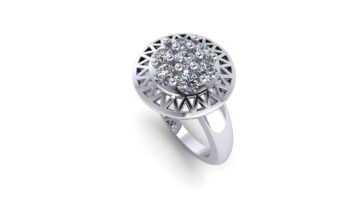How To Pick Colored Gemstones For Gemstone Jewelry
When one imagines an engagement ring, a diamond ring typically comes to mind, not Gemstone Jewelry. Traditionally, and especially since DeBeers launched the “A
Diamond Is Forever” marketing campaign, diamonds have reigned supreme for engagement rings. As a result, brides to be expected a diamond when getting engaged.
And this is despite such historical figures such as Napoleon giving his future empress, Joséphine, a sapphire and diamond toi et moi (“you and me”) ring as her
engagement ring. And the bigger the better too! However, this has been changing over the last decade as women buck the norm and go for Gemstone Jewelry that has
more meaning to them or that shows their personality more.
Celebs Have Led The Way on Gemstone Jewelry
Just look at the engagement rings of Kate Middleton, Katy Perry, or Gwyneth Paltrow. They chose their own paths and created rings with sapphires and a ruby for their
center stones. And once the normal female saw this trend, Gemstone Jewelry shot up in popularity. But if choosing a diamond for your engagement ring can be tough,
choosing a colored gemstone can be far more difficult. There are hundreds of gemstones, but not all are suitable for jewelry. Then, there is no set grading scale for colored
gemstones like the GIA diamond grading system. So, buyers are kind of at the whim of whatever they are told by colored gemstone dealers. And that is never a good
situation when looking for the best stone at the best price. Or, the one that you want.
Our customer was one of those who wanted something other than a diamond in her engagement ring. She knew she wanted a pink stone, but could not decide between tourmaline, morganite, and sapphire. She wanted a darker pink, so that knocked morganite out. We then told her that a sapphire is more durable and that was her deciding factor. Sapphires also have more luster than a tourmaline when polished well.
How Colored Gemstones Are Graded
While the most important aspects of a diamond are the 4 C’s, they do not have the same significance for colored gemstones. Although all gemstones have a cut, clarity,
color, and carat weight, those attributes are looked at differently than with diamonds. For colored gemstones, the color is easily the most important characteristic of the
stone. It is the key factor that sets the prices of colored gemstones and what makes one specimen of the same species more desirable than another.
Gemstone Color
Creating the color that your eye sees in colored gemstones are the hue, saturation, and tone. The combinations of the three are what give a colored gemstone its color. And there are an infinite number of combinations, which is why different species can display such a wide variety of colors and shaped within a color. Additionally, it is a reason that makes buying Gemstone Jewelry tougher than diamond jewelry as well.
Saturation: This is the intensity or purity of the color.

Tone: This is how dark or light the color of a stone is. In the GIA (and most others) color-grading system, tones range from very light to very dark.

Hue: This is the dominant color on the spectrum that the stone shows. It can also describe multiple colors that can be seem such a blue-gree ssapphire.

Just because you want Gemstone Jewelry doesn’t mean you can’t use diamonds as well. In this three stone engagement ring, a stunning sapphire is the main stone while the rest are all diamonds.
Gemstone Cut
Due to the differing physical and optical properties, colored gemstones do not have an ideal ‘brilliant cut’ like Diamonds. The style, cut and shape a stonecutter will select
depends on the type, shape and quality of the rough gemstone. For example, many emeralds are so included that it is only to make cabochons out of the rough material. If
they were faceted, they run the risk of crumbling. They would also be even less durable than the already fragile emerald. The cut of a colored stone directly affects its overall appeal. This is because the cut can determine how well a colored stone returns its body color back to the eye when light enters and leaves it.
Cutting colored gemstones is a tightrope and balance of saving as much weight as possible while yielding the best hue, saturation, and tone for that species. As a result,
stonecutters always try to find the best and most affordable mix of color and weight. During creation, a gemstone’s size is constrained by nature. For example, while large
and beautiful amethysts are readily available, an alexandrite of large size is extremely rare.
Cut Can Mean Both Shape As Well As Cutting Style
Fire and luster help to create the beauty of a well-cut colored gemstone. You can have 2 stones cut from the same piece of rough and the one with the better cut will be
more desirable 100% of the time. The cut of a colored gemstone can also be used to describes its shape and whether or not it is faceted. Some gemstones, such as
turquoise, are more suited to a smooth, rounded surface. This is because they are very soft and can have cracks in them, meaning they can fall apart when faceted. Other
stones like a ruby are usually cut with a precise series of flat, symmetrical planes, called facets, if the stone is of decent quality. If it isn’t, it will be cut into a cabochon.
Black is a color too! We create a lot of Gemstone Jewelry with black stones. Here, we used a black onyx for the center stone. While not as durable as a black diamond, it can have more luster due to better clarity, and the price is far less than that of black diamonds.
Gemstone Clarity
The clarity of colored gemstones, as with diamonds, does describe the inclusions in a gemstone. But inclusions aren’t always a bad thing for a colored gemstone and
sometimes are desirable like in a rutilated quartz. Unless a gemstone is opaque stops the light from refracting inside of it, how light bounces through the tone affects its
desirability. Some gemstones as a species will have very few or no internal inclusions to stop the refraction of light entering the stone, Tanzanite is one of these stones.
Generally speaking, tanzanite are both loupe and eye clean. If you were to find a specimen of Tanzanite with eye visible inclusions, it should be priced to reflect the lack of
desirability. On the other hand, some gemstones have characteristic inclusions that if aren’t there, can lower the price For example, a trapiche emerald is rare variety of
emerald, characterized by a six starred circular pattern of ray-like bands of black dendrite inclusions. The more perfect and pronounced the radial pattern is, the more
valuable the stone is.
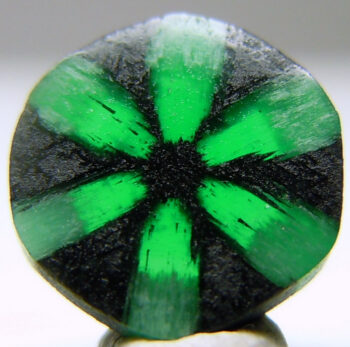
While not a very symmetrical stone, this trapiche emerald is a very good specimen with a highly pronounced radial pattern.
Gemstone Toughness
A gemstone’s ability to be worn, set, and cut is a direct result of how durable it is. Durability means both hardness and toughness. Some gemstones, such as sapphire, ruby
and garnet, are very hard and rank over 7.5 on the Mohs Scale of Hardness. Diamonds are a 10. Any stone with above a 7 on the Mohs scale would be suitable to mount in
gemstone jewelry. They would also stand up to to an active life and withstand the wear and tear that items such as rings, cufflinks, and and bracelets would endure.
Others, such as emeralds, pearls and opals are far softer and have a Mohs rating of around 5. Stones this soft are better suited for earring or necklace mountings where
they are not subject to the wear and tear that something like a ring does.
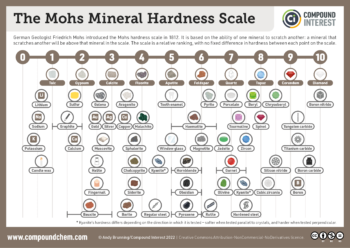
Here is a nice matrix of different stones and their Moh’s Hardness in comparison to things like a fingernail, which is a 2.5. Yuu generally want to stay above a 4 if you want to be able to set a stone into Gemstone Jewelry.
Gemstone Size
Unlike diamonds, colored stones are talked about by size and not weight. This is because each species has its own specific gravity and weight. So, a 7mm stone could find
lots of different weights depending on the type of stone. Also, colored stones are generally cut deeper as it maximizes the amount bodycolor displayed. However, like a
diamond, gemstone weight is measured carats. The jewelry industry also measures colored gemstones by dimensions in millimeters, not inches. While it can be confusing
for those not in the industry. Using the metric system is more precise and easier to use than inches.
Here, we went all color with pink sapphire and alexandrite. These were the birthstones of the couple. So there can be lots of personal reasons to choose Gemstone Jewelry over diamond. And they can make the ring that much more special with the added meaning.
Gemstone Treatments
In most colored gemstones, the color color occurs naturally and without any treatment. For example, spinels a stunning gemstone showing a variety of colors. Spinels are
generally loupe clean and are a very underutilized stone. And this is despite the fact that the red spinel was historically thought to be a ruby until technology was able to
identify spinel as its own species. Same with red garnets. In fact, the red stones in queen of England’s crown was thought to have been made with rubies until they were
identified as garnets using a laser microscope.
The most common treatment (and least invasive) is heat treatment. This is when a stone is exposed to high heat to alter its co lor and or clarity.
Heat treatment has been tried on spinels and garnets but it typically made the color less desirable. In many colored gemstones, the end bodycolor is revealed with once
heat is applied. Ever since ruby was found,they have been heat treated to achieve the desirable red color. Otherwise, they can be dull and more brown than red. However,
while the vast majority of rubies are heat treated, some have a naturally occurring red color. Because of the rarity, an unheated or untreated stone will be far more valuable
than one that has been treated.
The Most Typical Treatments Used Are As Follows:
Fracture Filling – This involves filling surface-reaching fractures or cavities with a glass, resin, wax, or oil. This serves to make the inclusion disappear and improves the apparent clarity as well. The filling materials vary from being solids (usually a lead glass) to oils, to colored dyes. You see this alot in rubies and emeralds.
Surface Coatings – This involves changing the appearance of a gemstone by applying a coloring agent such as paint to the backs of gems. We call this “backing”. It can also mean applying paint as a coating to all or a portion of a gemstone’s surface with the effect of altering the color. Topaz is almost always coated with a type of metal oxide to give it the different colors it comes in. How you can tell is the price. Coated stones will be inexpensive while natural ones can command $500 a carat.
Dying – This involves adding colored dyes into porous gems to change their color. It also works on stones like emerald that have surface reaching inclusions. These types of fractures are sometimes created on purpose by heating the gem so that it can more readily accept the dye. Pearls and coral are two of the most common types of gem to be dyed.
Bleaching – This involves using a chemical used to change or minimize an aspect of a porous gem. Some gemstones are even bleached and then dyed. The most common types of gemstones that get bleached are jadeite and pearls.
Irradiation – This entails “zapping” a gem with an artificial type of radiation to change its color. This is sometimes reinforced by heat treatment to further enhance the color.
Lattice Diffusion – This involves the introduction of certain elements such as titanium and chromium into the atomic structure of a gemstone during heat treatment. Used mainly with sapphires, it gives the stone a much more desirable color.
Ask Questions About Your Gemstone Jewelry
By law, all treatments are to be disclosed before a sale. If you pay the untreated price for a stone and get a treated one, you could be losing a lot of money. So make sure to
ask if the stones being used in your Gemstone Jewelry are treated. And of so, what type.
Give Us A Shot For Your Gemstone Jewelry! You Will Be Glad You Did.
You may like style of a ring but its shape is not what you like. Or, do you love the the design of the one part of an engagement ring, but don’t like the rest of it? The solution
to your conundrum lies in having a custom engagement ring created just for you. We are able to create one from the ground up if that is what it takes to make your dream a
reality. Or, we can cobble together a ring made from different aspects of a few rings. Instead of going for mass produced pieces, why not transform your own desire into
reality?
While Gemstone Jewelry is one of our specialties, we don’t limit ourselves to that! Regardless of whether it is a diamond wedding band, custom pendants, or bracelet, we can make
anything with gemstones.
Give Us A Shot!
You can view our portfolio of custom engagement rings to look for ideas. Or you can contact us with your own idea Note we can make anything you see on our website into Gemstone Jewelry.
Click HERE to lean more about custom jewelry, to view our the rest of our custom jewelry creations, or to contact us about Gemstone Jewelry. It can cost less than you think to have your very own custom engagement ring made. Why settle for boring, uninspiring, and made for the lowest common denominator with the most appeal jewelry from mass retailers? We can make exactly what you want. Don’t see what you are envisioning for your unique engagement ring? Send us the design you want and we will bring it to life.
